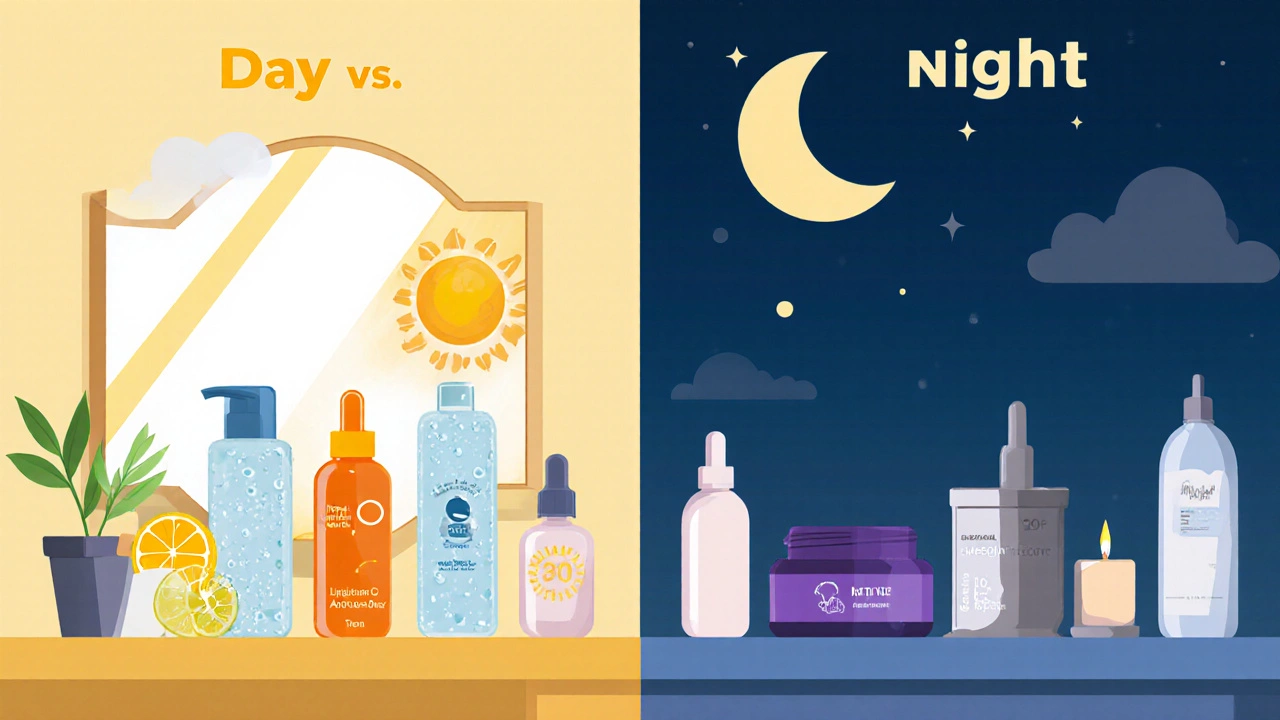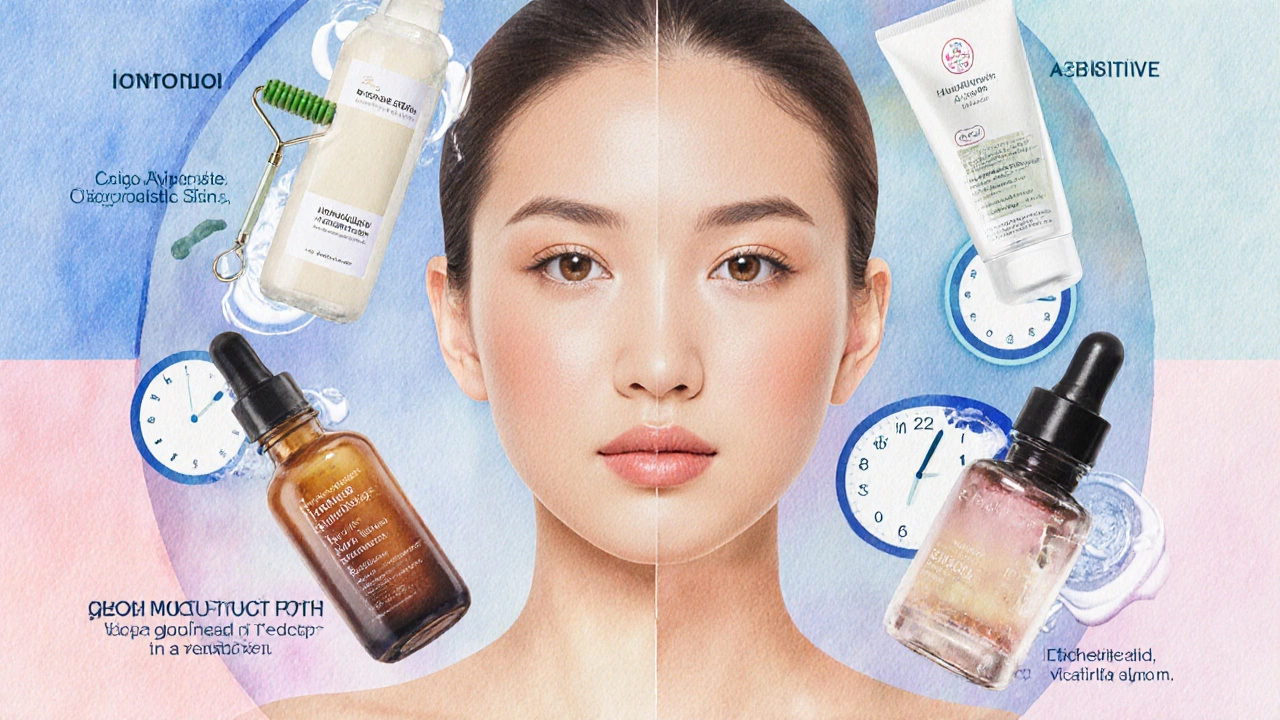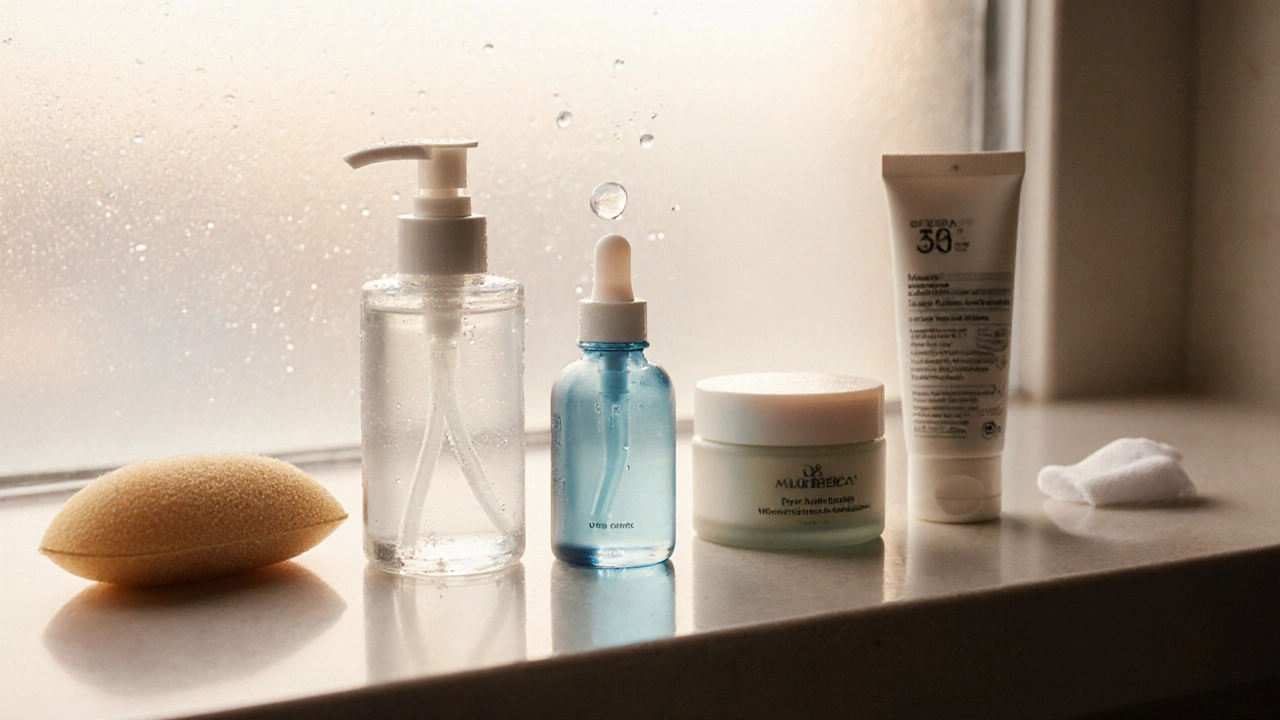Skincare Routine Guide
Select Your Skin Type
Normal
Balanced skin
Dry
Tight, flaky skin
Oily
Shiny, prone to breakouts
Combination
Dry cheeks, oily T-zone
Sensitive
Irritated, red skin
Time of Day
Your Recommended Routine
Select your skin type and time of day to see your personalized routine.
Checklist for Proper Application
When you hear the phrase skincare routine order is the sequence in which you apply your skincare products to maximize absorption and effectiveness, you probably wonder where to start. The good news? You don’t need a chemistry degree-just a clear roadmap and a few pro tricks.
Why the Order Matters
Think of your skin like a sponge. If you pour water on top of oil, the water slides off. The same principle applies to lotions, serums, and actives. Applying products from lightest to heaviest ensures each layer can do its job without being blocked. Skipping steps or mixing them in the wrong order can lead to pilling, irritation, or wasted money.
The Classic Five‑Step Order (Morning & Night)
Most dermatologists agree on a core sequence that works for the majority of skin types. Below is the baseline, and you can add or subtract based on personal needs.
- Cleanser is a water‑soluble product that removes dirt, oil, and makeup. Use a gentle, pH‑balanced formula; rinse with lukewarm water.
- Toner is a liquid that restores pH, adds a thin layer of hydration, and preps skin for actives. Pat it in with a cotton pad or hands.
- Serum is a concentrated treatment containing antioxidants, hyaluronic acid, or peptides. Apply a few drops and let it sink in.
- Moisturizer is a barrier‑forming cream or lotion that locks in moisture. Choose a texture that matches your skin’s oiliness.
- Sunscreen is a broad‑spectrum SPF product that protects against UVA and UVB rays. This step is non‑negotiable for daytime.
If you have specific concerns-acne, hyperpigmentation, or fine lines-add targeted actives (exfoliants, retinoids, or spot treatments) in the appropriate slot, which we cover next.

Day vs. Night Variations
Some steps shift after dark because the skin’s repair cycle ramps up while you sleep. Below is a quick visual comparison.
| Step | Morning (Day) | Evening (Night) |
|---|---|---|
| 1. Cleanse | Gentle morning cleanser | Double‑cleanse if you wore makeup |
| 2. Tone | Hydrating toner | Alcohol‑free soothing toner |
| 3. Exfoliate | Optional chemical exfoliant (2‑3×/week) | Retinoid or AHA/BHA (alternate nights) |
| 4. Serum | Antioxidant serum (vitamin C) | Repair‑focused serum (peptides, niacinamide) |
| 5. Eye Cream | Lightweight eye gel | Richer eye cream with peptides |
| 6. Moisturizer | Oil‑free day cream | Richer night cream or sleeping mask |
| 7. Sunscreen | SPF 30+ broad‑spectrum | - (skip sunscreen at night) |
Tailoring the Order for Different Skin Types
Not all skin is created equal. Identify your skin type first; then tweak the sequence to suit its needs.
- Normal is balanced oil and moisture, few sensitivities - follow the classic order, add a light antioxidant serum in the morning.
- Dry is tight, flaky, low sebum production - prioritize hydrating toners, hyaluronic‑acid serums, and a richer night cream.
- Oily is excess shine, larger pores, prone to breakouts - incorporate a salicylic‑acid toner, lightweight gel moisturizers, and oil‑free sunscreen.
- Combination is dry zones (cheeks) and oily zones (T‑zone) - use a balancing toner, apply richer cream only on dry areas, keep the rest light.
- Sensitive is easily irritated, prone to redness - stick to fragrance‑free, barrier‑repairing products; avoid harsh exfoliants.
Common Mistakes and How to Fix Them
Even seasoned skincare fans slip up. Spot the error, then correct it.
- Skipping toner. Many think it’s optional, but toner preps the skin and can add a hydration boost. Use a gentle, alcohol‑free formula.
- Layering too many actives. Vitamin C, AHA, and retinol together can irritate. Limit to one strong active per routine and alternate nights.
- Applying sunscreen under makeup. Sunscreen should be the final step; if you need a set‑up, use a mineral powder sunscreen on top of foundation.
- Rubbing instead of patting. Vigorously rubbing can damage the skin barrier. Pat products in with clean fingertips.
- Using the same order for day and night. Nighttime is the repair phase; swap antioxidant serums for retinoids or richer moisturizers.

Pro Tips for Layering and Application Techniques
These nuggets come from estheticians and dermatologists who work with clients daily.
- “The 30‑second rule.” Wait about 30 seconds between layers so each product can be absorbed before the next one lands.
- Warm up serums. Rub a few drops between palms; the warmth helps the serum spread evenly.
- Use a facial roller. After serum, gliding a jade roller can promote circulation and aid absorption.
- Layer from thinnest to thickest viscosity. If you’re unsure, squeeze a small amount of each product onto your hand and compare how they feel.
- Store actives away from light. Vitamin C and retinoids degrade fast; keep them in opaque containers.
Quick Checklist Before You Hit the Mirror
- Cleanse - remove yesterday’s grime.
- Toner - balance pH and add a hydration base.
- Targeted treatment - serum, eye cream, or spot treatment.
- Moisturizer - lock in all the layers.
- Sun protection - only in the morning.
- Wait 30 seconds between each step.
- Adjust actives based on day/night schedule.
Frequently Asked Questions
Do I need to use a toner if I already use a serum?
Yes. Toner restores the skin’s pH after cleansing and creates a thin, hydrating layer that helps the serum penetrate more effectively. Choose a toning solution that matches your skin type - hydrating for dry skin, soothing for sensitive, or clarifying for oily.
Can I apply sunscreen before my moisturizer?
Generally, no. Sunscreen should be the final barrier to protect the skin from UV rays. Applying moisturizer first can dilute the sunscreen and reduce its SPF rating. If you need extra hydration under sunscreen, look for a moisturizer‑in‑sunscreen hybrid.
How often should I exfoliate?
For most skin types, 2-3 times per week is enough. Over‑exfoliating can strip the barrier and cause redness. If you have sensitive skin, stick to once a week or use a very gentle enzyme exfoliant.
Is it okay to skip moisturizer if I have oily skin?
Skipping moisturizer can actually trigger more oil production. Choose a lightweight, oil‑free gel moisturizer that hydrates without feeling heavy. Your skin will thank you with a more balanced shine.
Should I use different serums for morning and night?
Morning serums usually focus on antioxidant protection (vitamin C, ferulic acid) while night serums target repair (peptides, retinol, hyaluronic acid). Switching them maximizes both defense and regeneration.

